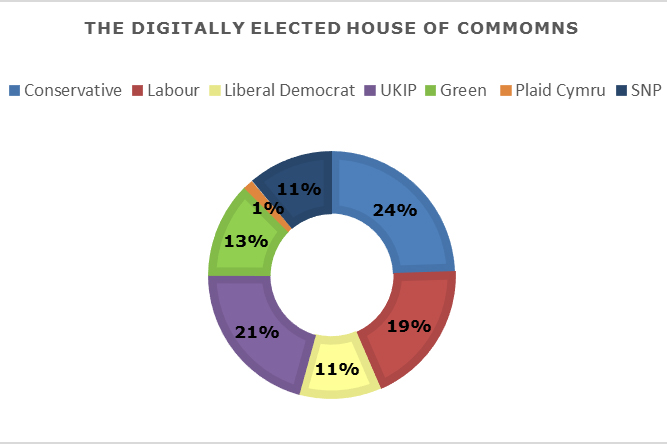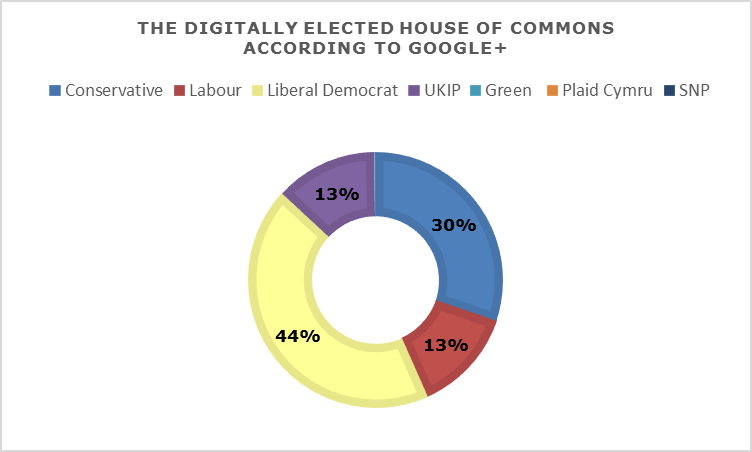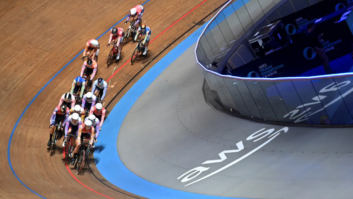
With just one day to go to the ballot, research by specialist marketing recruiter EMR examines the social media presence of the seven main political parties and reveals how the House of Commons would look if seats were allocated according to followers or likes on social media.
It reveals, as of 5 May, the Tories have the biggest aggregate following across Twitter, LinkedIn, Facebook and Google+ with just over 651,000: 24 per cent of the total 2.6 million ‘digital votes’ across the four social media platforms. Labour trails behind with 19 per cent – more than 146,000 behind the Conservatives – and UKIP currently occupies second place with over 551,000 followers: 21 per cent of the total following for the main political parties. The Green Party has 13 per cent of the aggregated following and 332,000 digital votes, with the Liberal Democrats and SNP closely behind with 11 per cent of the vote apiece.
Charlie Fey, director at EMR, commented: “The flurry of digital activity to accompany every pre-election promise shows that political strategists are taking heed of what communications professionals have long known: that an effective digital offering is fundamental to any winning campaign.

“The less established parties may well be pining for a digital democracy following the results of our research. A Parliament built on social media would see the Greens take 78 seats and UKIP 137: many more than they are likely to win under the current electoral system.”
The research also reveals a clear divide in party loyalties across the main social media platforms. Despite trailing in the overall poll, Labour is in top spot on Twitter with 26 per cent of the digital vote, ahead of the Tories on 19 per cent and Green Party on 17 per cent.

On Facebook, the Conservatives and UKIP share 52 per cent of the vote, giving them a narrow majority. In contrast, the Liberal Democrats trail the Labour, SNP and Green parties with just 7 per cent of the combined Facebook following.
LinkedIn is the platform that comes closest to having a single party majority. The Conservatives’ traditional popularity with UK business translates into 47 per cent of the digital vote based on LinkedIn followers, almost three times as much as its nearest rivals. The Lib Dems narrowly secure second spot with 16 per cent of the vote compared with Labour’s 15 per cent.
The roles are reversed for the current Coalition partners on Google+ with the Lib Dems in top spot with 44 per cent of the digital vote, ahead of the Conservatives on 30 per cent. It makes Google+ the only social media platform where the Lib Dems have a larger following than any other party.

“Stereotypes ring true when we look at how parties are performing on specific platforms, with the Conservatives’ leadership on LinkedIn illustrating the party’s popularity among the business community,” added Fey. “Furthermore, the Lib Dems’ image as an alternative to the mainstream has seemingly translated into success on the relatively new stage of Google+, where they are streets ahead of the competition with over 40 per cent of the vote.
“While a loss to UKIP in terms of aggregated followers may be tough for Labour to stomach, the party can take solace in its representation on Twitter. Labour has an impressive share of the Twitter ‘electorate’, which some observers might say ties in nicely with its image as the party of choice for the ‘chattering classes’.”







